Believe it or not, I’ve never made American-style fried chicken. My husband loves to chide me about how the recipe that I included in Into the Vietnamese Kitchen is fried chicken light, the modest pieces coated in bread crumbs or panko and fried to a crisp, served with a fish sauce-inflected sweet-and-sour sauce. He grew up with large pieces of chicken coated in flour and fried to a crisp. While that was a standard for him, it was exotic to me. When we shared an apartment in college, my brother and I sometimes ate Kentucky Fried Chicken as a novelty splurge.
Chinese lemon chicken and Korean fried chicken were good but not the same as old-fashioned American fried chicken, my husband contends. While we were in the South last year, we had wonderfully salty, crisp fried chicken at Uncle Lou’s in Memphis. I was looking for a good guide to making American-style fried chicken and decided to let Michael Ruhlman lead me.
I've had an advance copy of Michael’s new cookbook, Ruhlman’s Twenty, since mid-summer and stolen moments of free time to peruse his latest work. In a world of fast-and-easy, down-and-dirty, and semi-homemade, Twenty takes a different approach: Arm cooks with 20 foundational techniques to help them nimbly navigate the the world of cooking. It’s loaded with process photos to guide cooks through potential stumbling blocks.
Fried Chicken Brilliance
I was drawn to Michael’s Rosemary-Brined, Buttermilk Fried Chicken because he boldly touted it as "the best fried chicken, ever" but more importantly, it incorporated this technique: brining the chicken. One of my beefs about fried chicken is that underneath the crisp coating skin, the chicken isn’t often well seasoned. (For my Viet fried chicken light, the chicken is marinated with lots of garlic!) Michael credits the brining approach to the Chefs Jeff Cerciello and Dave Cruz at Thomas Keller’s Ad Hoc restaurant in Napa. Brilliant.
The other point of brilliance is letting the chicken air-chill after brining. Remember how I do that with Peking duck? Air-chilling the chicken dries up the surface moisture, allowing for the flour coating to adhere well. The flesh, after brining, is juicy and flavorful.
Good recipes and cookbooks explain techniques so that you understand the cooking process and feel comfortable about doing your own thing. Ruhlman’s Twenty empowers cooks with confidence and encourages them to practice and learn. You can’t ask for much more than that from a cookbook.
Adding Asian Elements
After getting my chicken legs, I studied Michael’s recipe and decided to veer a bit from it. Why? Because we’d just finished eating a pork roast that had been seasoned with rosemary from the garden. My rosemary bush is ironically right next to the makrut (kaffir) lime tree. The swap suddenly seemed natural. It was kismet.
Based on Michael’s original recipe, I guesstimated the amount of lime leaf needed. I also halved his recipe, which fed 6 to 8 people. We are a family of 2 hungry adults so a yield of 4 servings made more sense for our situation. In addition to substituting the lime leaf for the rosemary, I took these steps to further Asianize the chicken:
- Doubled the garlic in the brine
- Replacing some of the kosher salt with fish sauce in the brine
- Using Korean red pepper powder for the paprika and cayenne in the flour coating
- Serving the fried chicken with Thai sweet chile sauce
What was cool is that the brine ended up tasting like a Vietnamese/Thai soup. I could have added some seafood to it and been happy as a clam. (Ha!) But instead I let the chicken sit in the brine overnight.
Timing and Ideas for Tinkering
I started the chicken two days before I wanted to eat it to allow for brining and air-chilling. You could do it just a day ahead. In any event, when I went to fry, all I had to do was flour, dip, flour and heat up the oil. Most of the prep had been done in advance so it was no sweat. Very smart cooking to produce truly excellent fried chicken. Once fried, the chicken kept well at room temp for about 2 hours. Frankly, it smells so good you can’t resist eating it for that long.
After I made the chicken, I thought of a few ways to change things up the next time around. Feel free to share your ideas in the comments section:
- Instead of the lime leaves, use lemongrass or more garlic.
- Tinker with the flour coating. Keep the salt because it gives the fried chicken that bad-ass saltiness but use other seasonings in place of the pepper and chile. Add them to the flour and taste the flour. Sounds weird but you can gauge the overall flavor that way.
- Instead of the Thai sweet chile sauce, you could eat the chicken with one of the Korean fried chicken sauces, a sweet and sour sauce (see Into the Vietnamese Kitchen or Asian Dumplings for recipes on pages 312 and 217, respectively), or even Indonesian sweet soy sauce (kecap manis) with lime juice and chile slices.
- Serve the kaffir lime fried chicken with coconut pandan waffles and Thai sweet chile sauce for an Asian take on Roscoe’s chicken and waffles.
You get the idea. Here’s the fried chicken recipe for you to play with:
Recipe
Makrut Lime Fried Chicken
As for the two kinds of salt, the Kosher has a sweet-saltiness. If you replace it with regular salt (e.g, uniodized table salt) or sea salt, use 1 ½ teaspoons. For a bad-ass saltiness, use sea salt as it lends a nice savory depth.
Do your best to get medium size chicken legs so that the chicken cooks through. If you end up with some large legs (that sounds awful, doesn’t it?), halved the thighs along the bone to create smaller, manageable pieces; punt with the drumstick.
Serves 4
Brine
½ teaspoon canola oil
½ small yellow onion, thinly sliced
4 garlic cloves, smashed
1 tablespoon Kosher salt
12 makrut lime leaves
2 ½ cups water combined with 1 ½ tablespoons fish sauce and juice of ½ lime
6 medium chicken legs, drumsticks and thighs separated
1 ½ cups all-purpose bleached or unbleached flour
1 ½ tablespoons freshly ground black pepper
1 tablespoon Korean red pepper powder, or 1 tablespoon paprika plus 1 teaspoon cayenne
1 tablespoon fine sea salt
1 tablespoon baking powder
1 cup buttermilk
Canola oil, for deep-frying
Thai Sweet Chile Sauce, optional
1. For the brine, heat the oil in a medium saucepan over medium-high heat. Add the onion and garlic and cook, stirring for about 30 seconds until the onion starts to soften, then add the Kosher salt. Keep stirring and cooking for about 3 minutes, until the onion is translucent. The bottom of the pan may look a little funky and gummy.
Add the lime leaves, cook for another 30 seconds, until you can smell their fragrance. Then add the seasoned water. Bring to a simmer, then remove from the heat. Let cool completely, uncovered, before moving on.
2. Put the chicken into a plastic zip-top bag and set the bag in a bowl. Add the cooled brine and all the aromatics. Seal the bag, expelling the air well. The chicken should be more or less surrounded by the brine. Refrigerate the bowl for 8 to 24 hours. Occassional agitate the bag so ensure even exposure to the seasonings.
3. Remove the chicken from the brine and discard the brine. Rinse the chicken under cold water, pat dry with paper towel, then put the pieces on a rack positioned in a rimmed baking sheet. Slide the chicken into the refrigerator, uncovered, for 8 to 16 hours. This allows the chicken to dry out. If you like, flip the pieces over midway. You’ll see the skin darken a bit and feel just slightly moist to the touch. If you fear the chicken over drying, cover it with a piece of parchment or wax paper but keep the chicken chilled.
4. About 30 minutes before frying, remove the chicken from the fridge and let it sit at room temperature to remove some of the chill.
Meanwhile, set up your frying station. In a medium bowl, combine the flour, black pepper, red pepper, sea salt, and baking powder. Pour the buttermilk into a small bowl. Have a different rack set in a baking sheet ready near the stove for draining and cooling the chicken.
Dredge all the chicken pieces in the flour, shaking off the excess, then set them aside on a dry surface. Now coat each piece in buttermilk, letting the excess drip back into the bowl, before re-dredging the chicken in a second coating of flour. I usually work with 2 pieces of chicken at a time. Place the coated chicken back on the rack.
5. Heat 1 ¾ to 2 inches of oil in a large wok or dutch oven to 350F. Fry the chicken in batches of 4 or 5 pieces, turning occassionally, until cooked through, 10 to 14 minutes, depending on the size of the pieces. The finished chicken should be crisp and a rich golden brown.
The oil temperature will decrease during frying and in general, I like to keep the temperature between 300F and 320F, or the chicken browns too quickly. If your chicken browns too quickly, lower the temperature to coax it to cook longer. Return the oil to temperature between batches.
Let the chicken cool for 5 to 10 minutes on the rack before serving with the sweet chile sauce on the side.
Related Recipes













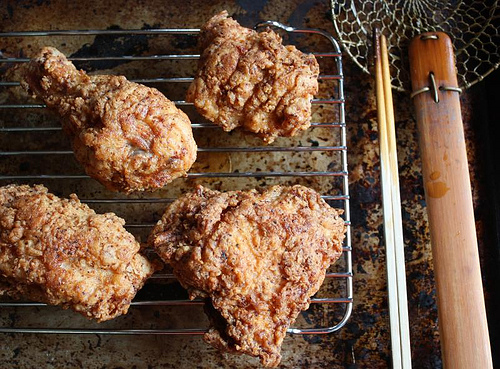
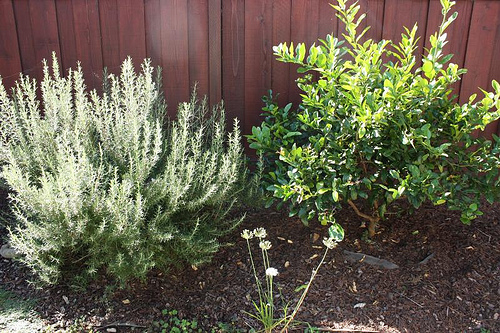
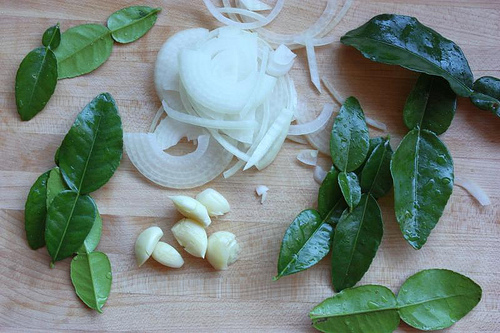
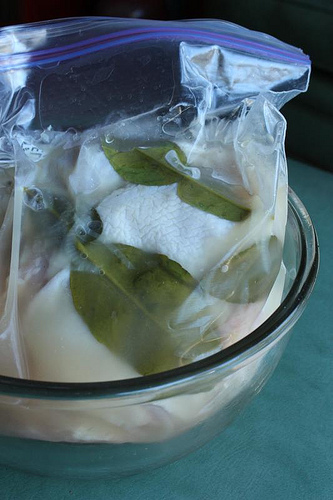
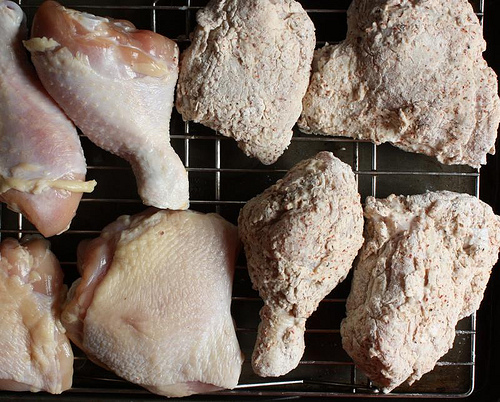
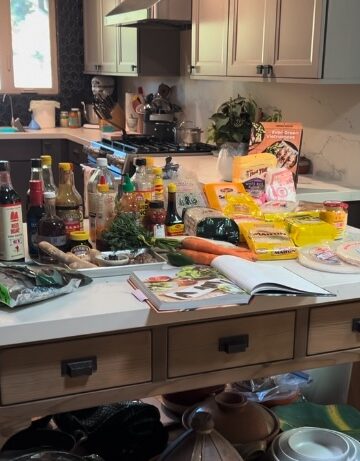



kristina nicholas says
my mouth is watering....yum! thanks for the inspiration (and this has to be o' so much better than KFC).
Andrea Nguyen says
You're welcome Kristina! This is a ZILLION times better than KFC. Better yet, you can do a lot with it. Have it your way.
Heather in SF says
I love that - bad assed saltiness! I have been craving fried chicken like there's no tomorrow, your pictures have sealed the deal; I'm telling my stomach to shuttie...
Andrea Nguyen says
Heather: LOL. Fried chicken is about being bad, ain't it? Fried chicken skin, salt, crunchy bits... I figure if I make it myself I burn a few calories in the cooking and clean-up. Enjoy!
Donna says
Thanks for the great step by step instructions. I've never made fried chicken at home--my mom never fried things, I don't know why. And never having grown up with fried food, I have this fear of grease fires, which I don't even know how it happens, or how common it is, I just remember a friend whose had a bad house fire when her son was deep frying tortillas and a fire started. The few times I've tried frying I feel the chicken came out greasy because the oil wasn't hot enough because I was thinking Oh! is it smoking? isn't that bad! doesn't that mean it's going to catch fire? So how cautious do you have do be? Have I written an entire post that is making everyone laugh 😎 ?
Yun Ho Rhee says
Hi Andrea:
Your recipe looks great. How much lemongrass would you recommend since it is hard to find lime leaves here in Korea? I will try using "spicier" Korean chili pepper powder to give that extra kick!!
Ting Gough says
This is great! I'm always looking for new ways to use my homegrown lemongrass and kaffir lime. Thanks.
http://tingplayingwithfood.blogspot.com/
Andrea Nguyen says
Yun Ho: I'd say try 2 fat stalks of lemongrass. You want to smell its perfume. Thought you'd like the use of gochu garu.
Andrea Nguyen says
Donna: I've never had a deep-frying, grease-fire. My sense is if you use a thermometer to gauge the temp, you'll be control of the heat. If you pour enough oil into the pan/skillet/wok so that it reaches the rim AND you overheat the oil -- say to smoking, then you're creating a fire hazard.
I like to use a wok to deep-fry because it heats up the oil quicker and you don't have to use as much oil, due to the natural curve of the wok. Here's a Taylor thermometer that gets a lot of use in my kitchen:
http://amzn.to/pQmpVT
Yun Ho Rhee says
Thanks Andrea, I will make these chicken over the weekend and you should call it Chicken a la Andrea!!
Andrea Nguyen says
Yun Ho: You could serve the fried chicken with a side of kimchi.
Jacqueline says
This looks amazing as is, but kaffir lime leaves hard to find here.
What about curry leaves and garam masala flour?
5 Spice flour with brine incl cumin, coriander, soy?
mcs3000 says
Made a second batch of your chicken tonite - so marvelous. Your duck recipe had already sold me on the merits of air-chilling. Lime leaves, fish sauce + Korean red peppers = genius. I also put some onions rings in the brine and batter. Made a great side dish. Thank you again, Andrea! btw: I am so excited about your NEW book.
Andrea Nguyen says
@Jacqueline: Curry leaves would be good. You can get those but no kaffir lime leaf? Great ideas that you came up with. The only thing I'd avoid too much of in the flour is turmeric. That would get the chicken to brown too quickly.
Andrea Nguyen says
@mcs3000: Onion rings, oh my. Fantastic idea.
Thanks for the interest in tofu too! 🙂
Canada Goose sale says
It is then take at least 2 cups of water and add half cup of ammonia into it.
gordsellar says
Argh, lost the first version of this comment to the ether:
Yun Ho, you can get fresh lemongrass in Seoul, at this place:
http://wiki.galbijim.com/Black_markets#Foreign_Food_Mart
I think they deliver to places outside Seoul, too. There's an email address and phone number at the page linked. I've gotten kaffir lime leaf using Gmarket, too.
As for a side dish, Andrea, I'd be tempted to go with something that cuts the grease... maybe I've been in Korea too long. (There always seems to be a side dish for any oily food, to cut the grease: pickles with pizza, jalapenos and pickles with Italian pasta; danmuji and onions in vinegar with "Chinese food".) I'm thinking I'd serve with a nice white water kimchi -- one with lots of white radish and little or no hot pepper. Then again the side dish they offer with my favorite Korean chicken dish -- dalk dori tang, in a tiny little place in Jeonju that is just to die for -- is peeled, fresh carrots. Somehow matches perfectly with the rich chickeny broth, and might go nicely with this too. 🙂
cheap canada goose says
Towering genius disdains a beaten path. It seeks regions hitherto unexplored.
ime and tide wait for no man.
come on!!!!
canada goose says
What's in a name? That which we call a rose by any other name would smell as sweet.
Beats by Dr Dre says
We do not choose to be born. We do not choose our parents. We do not choose our historical epoch, the country of our birth, or the immediate circumstances of our upbringing. We do not, most of us, choose to die; nor do we choose the time or conditions of our death. But within all this realm of choicelessness, we do choose how we shall live: courageously or in cowardice, honorably or dishonorably, with purpose or in drift. We decide what is important and what is trivial in life.
Beats by Dr Dre says
When one loves one’s art, no service seems too hard.
Red Bottom shoes says
Cleanliness is next to godliness.
David says
A Kentucky fried chicken recipe sure is popular among home cooks and getting your hands on one will surely be a great privilege and a chance to give the famous recipe a try and serve it to your family at home. Although there are a lot of people who claim to have found the secret to this famous recipe, there still is something that only a home cooked meal can do and that is giving it your own taste. Doing this at home will allow you to have adjustments on the taste, to the size of every portion and so much more that you can do with it. Find out more recipes on our site:
http://kentuckyfriedchickenrecipe.org/
kinh thoi trang says
This is actually a byproduct experimental cooking from the left over of the Tom Yum Ingredient I made last weekend. I thought it would be cool to play around with ingredient that has a stronger taste. Mixed it up with a little oriental style (Deep Fried Bee Hun) and a little western taste (mayonnaise) to it.
lamb recipes says
oh my next to lamb i love chicken especially fried because you can always add flavor .thanks for sharing yours.
cheapnbajerseyssale says
Awesome!! Thanks so much for sharing!!!
cheapnbajerseyssale says
Awesome!! Thanks so much for sharing!!!